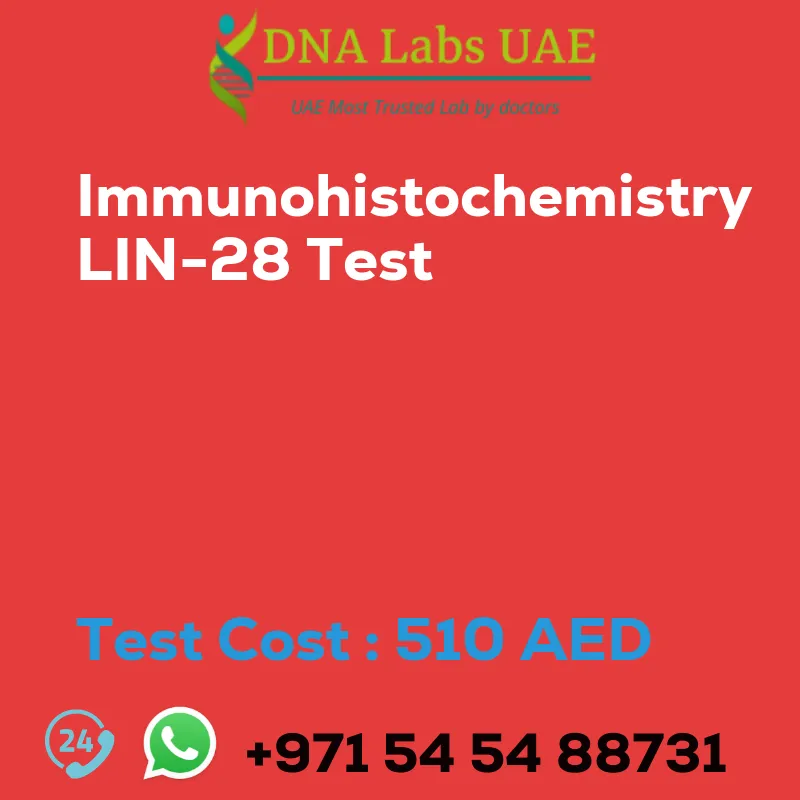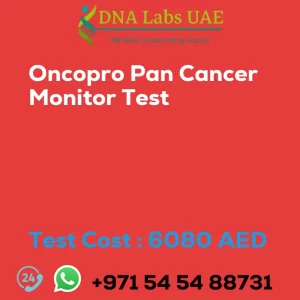IMMUNOHISTOCHEMISTRY LIN-28 Test
Cost: AED 510.0
Symptoms, Diagnosis, and Test Details
Are you experiencing symptoms that require further investigation? The IMMUNOHISTOCHEMISTRY LIN-28 Test offered by DNA Labs UAE might provide the answers you’re looking for. This test is specifically designed to detect specific proteins in tissue samples, helping doctors diagnose cancer and understand its progression.
Test Components and Price
The IMMUNOHISTOCHEMISTRY LIN-28 Test is priced at AED 510.0. It involves analyzing tumor tissue samples using immunohistochemistry techniques to identify the LIN-28 protein.
Sample Condition and Submission
To ensure accurate results, it is crucial to submit tumor tissue in either 10% Formal-saline or a Formalin-fixed paraffin-embedded block. The samples should be shipped at room temperature. Along with the samples, provide a copy of the Histopathology report, site of biopsy, and clinical history for a comprehensive analysis.
Report Delivery
The report for the IMMUNOHISTOCHEMISTRY LIN-28 Test will be delivered daily by 6 pm. The turnaround time for different sample types is as follows: Report Block: 5 days, Tissue Biopsy: 5 days, and Tissue large complex: 7 days.
Method and Test Type
The IMMUNOHISTOCHEMISTRY LIN-28 Test is performed using immunohistochemistry, a technique that detects specific proteins in tissue samples. This test specifically focuses on LIN-28, a protein marker commonly used to study its expression in various tissues. The test falls under the category of cancer diagnostics and is typically requested by oncologists.
Pre Test Information
Prior to the test, it is essential to provide a copy of the Histopathology report, site of biopsy, and clinical history. These details assist the laboratory in analyzing the samples accurately.
Test Procedure
The IMMUNOHISTOCHEMISTRY LIN-28 Test follows a specific procedure to ensure accurate results:
- Tissue preparation: Tissue samples obtained from biopsies or surgical resections are fixed in formalin and embedded in paraffin wax. Thin sections of the tissue are then cut using a microtome.
- Deparaffinization and rehydration: The paraffin-embedded tissue sections are deparaffinized using appropriate solvents like xylene. They are then rehydrated using decreasing concentrations of alcohol.
- Antigen retrieval: The tissue sections are treated with an antigen retrieval solution to unmask the target antigen and improve antibody binding.
- Blocking: Non-specific binding sites on the tissue sections are blocked using a blocking buffer containing a protein such as bovine serum albumin (BSA) or normal serum.
- Primary antibody incubation: The tissue sections are incubated with a primary antibody specific to LIN-28, allowing it to recognize and bind to the target protein.
- Secondary antibody incubation: After washing off unbound primary antibody, the tissue sections are incubated with a secondary antibody conjugated to a detection system, amplifying the signal for visualization.
- Visualization: The tissue sections are visualized either under a fluorescence microscope if a fluorescent dye is used or by adding a chromogenic substrate for an enzyme-based detection system.
- Counterstaining: In some cases, counterstaining with a dye like hematoxylin is performed to visualize cellular structures and aid in interpretation.
- Mounting: The stained tissue sections are mounted onto glass slides using a resin-based mounting medium to preserve the staining and protect the tissue.
- Analysis: The stained tissue sections are examined under a microscope to analyze and interpret the expression and localization of the LIN-28 protein.
The IMMUNOHISTOCHEMISTRY LIN-28 Test provides valuable information about the expression pattern and localization of LIN-28 protein in different tissues. This information helps researchers and clinicians understand its role in various biological processes and diseases.
Conclusion
If you suspect cancer or require further investigation into specific proteins, the IMMUNOHISTOCHEMISTRY LIN-28 Test offered by DNA Labs UAE is a reliable option. By analyzing tissue samples, this test provides insights into the expression and localization of LIN-28 protein, aiding in accurate diagnosis and treatment decisions.
| Test Name | IMMUNOHISTOCHEMISTRY LIN-28 Test |
|---|---|
| Components | |
| Price | 510.0 AED |
| Sample Condition | Submit tumor tissue in 10% Formal-saline OR Formalin fixed paraffin embedded block. Ship at room temperature. Provide a copy of the Histopathology report, Site of biopsy and Clinical history. |
| Report Delivery | Sample Daily by 6 pm; Report Block: 5 days Tissue Biopsy: 5 days Tissue large complex : 7 days |
| Method | Immunohistochemistry |
| Test type | Cancer |
| Doctor | Oncologist |
| Test Department: | HISTOLOGY |
| Pre Test Information | Provide a copy of the Histopathology report, Site of biopsy and Clinical history. |
| Test Details |
Immunohistochemistry (IHC) is a technique used to detect specific proteins in tissue samples. The LIN-28 protein is a marker that is commonly used in IHC to study its expression in various tissues. To perform an immunohistochemistry LIN-28 test, the following steps are typically followed: 1. Tissue preparation: Tissue samples, usually obtained from biopsies or surgical resections, are fixed in formalin and embedded in paraffin wax. The tissue is then cut into thin sections (usually 4-6 micrometers thick) using a microtome. 2. Deparaffinization and rehydration: The paraffin-embedded tissue sections are deparaffinized by incubating them in xylene or other appropriate solvents. The sections are then rehydrated by passing them through a series of decreasing concentrations of alcohol. 3. Antigen retrieval: The tissue sections are treated with an antigen retrieval solution, such as heat-induced epitope retrieval or enzyme-induced epitope retrieval, to unmask the target antigen and improve antibody binding. 4. Blocking: Non-specific binding sites on the tissue sections are blocked using a blocking buffer, typically containing a protein such as bovine serum albumin (BSA) or normal serum. 5. Primary antibody incubation: The tissue sections are incubated with a primary antibody specific to LIN-28. The primary antibody recognizes and binds to the target protein in the tissue sections. 6. Secondary antibody incubation: After washing off unbound primary antibody, the tissue sections are incubated with a secondary antibody conjugated to a detection system, such as a fluorescent dye or an enzyme. The secondary antibody binds to the primary antibody, amplifying the signal and allowing visualization of the target protein. 7. Visualization: If an enzyme-based detection system is used, a chromogenic substrate is added, which reacts with the enzyme to produce a visible color change. If a fluorescent dye is used, the tissue sections are directly visualized under a fluorescence microscope. 8. Counterstaining: In some cases, counterstaining with a dye, such as hematoxylin, is performed to visualize the cellular structure and aid in interpretation. 9. Mounting: The stained tissue sections are mounted onto glass slides using a mounting medium, such as a resin, to preserve the staining and protect the tissue. 10. Analysis: The stained tissue sections are then examined under a microscope, and the expression and localization of LIN-28 protein in the tissue are analyzed and interpreted. The immunohistochemistry LIN-28 test can provide valuable information about the expression pattern and localization of LIN-28 protein in different tissues, helping researchers and clinicians understand its role in various biological processes and diseases. |








